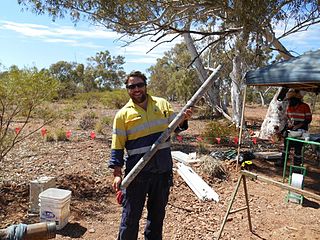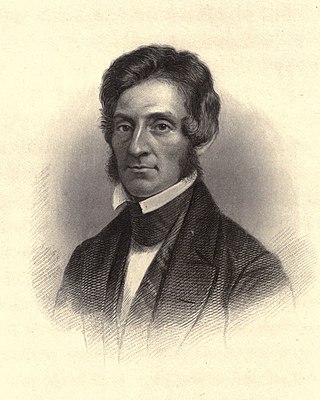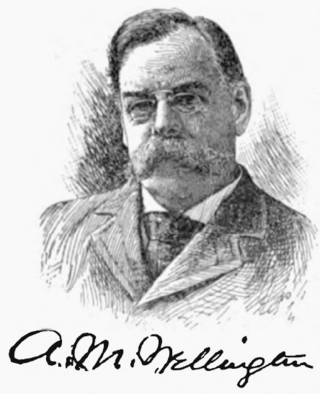
A cable car is a type of cable railway used for mass transit in which rail cars are hauled by a continuously moving cable running at a constant speed. Individual cars stop and start by releasing and gripping this cable as required. Cable cars are distinct from funiculars, where the cars are permanently attached to the cable.

The Central Pacific Railroad (CPRR) was a rail company chartered by U.S. Congress in 1862 to build a railroad eastwards from Sacramento, California, to complete the western part of the "First transcontinental railroad" in North America. Incorporated in 1861, CPRR ceased operation in 1959 when assets were formally merged into the Southern Pacific Railroad.

Theodore Dehone Judah was an American civil engineer who was a central figure in the original promotion, establishment, and design of the First transcontinental railroad. He found investors for what became the Central Pacific Railroad (CPRR). As chief engineer, he performed much of the route survey work to determine the best alignment for the railroad over the Sierra Nevada, which was completed six years after his death.

École des Ponts ParisTech is a grande école in the field of science, engineering and technology. Founded in 1747 by Daniel-Charles Trudaine, it is one of the oldest and one of the most prestigious French grandes écoles.

Thorstein Bunde Veblen was an American economist and sociologist who, during his lifetime, emerged as a well-known critic of capitalism.

Vernon Lomax Smith is an American economist and professor of business economics and law at Chapman University. He was formerly a professor of economics at the University of Arizona, professor of economics and law at George Mason University, and a board member of the Mercatus Center. Along with Daniel Kahneman, Smith shared the 2002 Nobel Memorial Prize in Economic Sciences for his contributions to behavioral economics and his work in the field of experimental economics. He worked to establish 'laboratory experiments as a tool in empirical economic analysis, especially in the study of alternative market mechanisms'.

Francis Ysidro Edgeworth was an Anglo-Irish philosopher and political economist who made significant contributions to the methods of statistics during the 1880s. From 1891 onward, he was appointed the founding editor of The Economic Journal.

Engineering geology is the application of geology to engineering study for the purpose of assuring that the geological factors regarding the location, design, construction, operation and maintenance of engineering works are recognized and accounted for. Engineering geologists provide geological and geotechnical recommendations, analysis, and design associated with human development and various types of structures. The realm of the engineering geologist is essentially in the area of earth-structure interactions, or investigation of how the earth or earth processes impact human made structures and human activities.

Dr. John Alexander Low Waddell was a Canadian-American civil engineer and prolific bridge designer, with more than a thousand structures to his credit in the United States, Canada, as well as Mexico, Russia, China, Japan, and New Zealand. Waddell’s work set standards for elevated railroad systems and helped develop materials suitable for large span bridges. His most important contribution was the development of the steam-powered high-lift bridge. Waddell was a widely respected writer on bridge design and engineering theory, as well as an advocate for quality in higher education engineering programs. The company he founded in 1887, 'J.A.L. Waddell, Consulting Engineer,' would eventually become the modern day Hardesty & Hanover, a leading moveable bridge engineering firm. Many of Waddell's surviving bridges are now considered historic landmarks.

Herman Haupt was an American civil engineer and railroad construction engineer and executive. As a Union Army General during the American Civil War, he revolutionized U.S. military transportation, particularly the use of railroads.

Wesley Clair Mitchell was an American economist known for his empirical work on business cycles and for guiding the National Bureau of Economic Research in its first decades.

Charles Ellet Jr. was an American civil engineer from Pennsylvania who designed and constructed major canals, suspension bridges and railroads. He designed and supervised construction of the Wheeling Suspension Bridge, the longest suspension bridge in the world, from 1849 to 1851. He conducted the first Federal survey of the Mississippi and Ohio rivers as part of the U. S. Army Corps of Engineers.
The efficiency movement was a major movement in the United States, Britain and other industrial nations in the early 20th century that sought to identify and eliminate waste in all areas of the economy and society, and to develop and implement best practices. The concept covered mechanical, economic, social, and personal improvement. The quest for efficiency promised effective, dynamic management rewarded by growth.
For the application of engineering economics in the practice of civil engineering see Engineering economics.
Samuel Skerry Montague (1830–1883) was a railway engineer responsible for building railways in the United States. He was appointed chief engineer of the Central Pacific Railroad in 1863. He also worked on the Southern Pacific Railroad and the First transcontinental railroad.

Industrial engineering is an engineering profession that is concerned with the optimization of complex processes, systems, or organizations by developing, improving and implementing integrated systems of people, money, knowledge, information and equipment. Industrial engineering is central to manufacturing operations.

Arthur Mellen Wellington was an American civil engineer who wrote the 1877 book The Economic Theory of the Location of Railways. The saying that An engineer can do for a dollar what any fool can do for two is an abridgement of a statement made in this work. Wellington was involved in the design and construction of new railways in Mexico. He was chief engineer of the Toledo and Canada Southern Railroad. He was the editor of the Engineering News.
Eugene Lodewick Grant, was an American civil engineer and educator. He graduated with a BS from the University of Wisconsin in 1917. He started teaching in 1920 at Montana State University and then in 1930 at the School of Engineering, Stanford University where he taught until 1962. He is known for his work in Engineering Economics with his textbook first published in 1930. Grant was the intellectual heir of work performed by John Charles Lounsbury Fish who published Engineering Economics: First Principles in 1923, providing the critical bridge between Grant and the pioneering effort of Arthur M. Wellington in his engineering economics work of the 1870s.
The study of Engineering Economics in Civil Engineering, also known generally as engineering economics, or alternatively engineering economy, is a subset of economics, more specifically, microeconomics. It is defined as a "guide for the economic selection among technically feasible alternatives for the purpose of a rational allocation of scarce resources." Its goal is to guide entities, private or public, that are confronted with the fundamental problem of economics.














